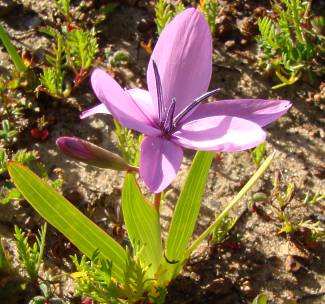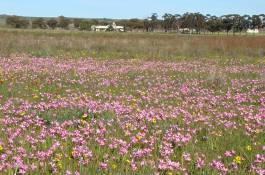Hesperantha pauciflora
Hesperantha pauciflora (Baker) H.J Lewis
Family: Iridaceae
Common names: pink evening flower, pink hesperantha (Eng.); pienkaandblom (Afr.)
Introduction
Hesperantha pauciflora is an attractive geophyte growing up to 150 mm high. This plant grows as a deciduous perennial and forms small tubers with a hard coating as a storage organ.

Description
Description
Hesperantha pauciflora flowers can range from pink to purple and very rarely yellow. The flowers are 20-25 mm across and unlike the other evening flowers (within the Hesperantha group) they open from midday to late afternoon. The leaves are usually sword shaped and pale green. Plants usually grow in clay soils in Renosterveld, but are also found on the sandstone soils of the Bokkeveld Plateau. During the hot summer months plants are dormant. With the first winter rains, Hesperantha pauciflora starts growing and flowers during spring. Plants may occur alone, or in clusters which create dense carpets of pink on the old lands or even among the shrubs in the renosterveld.

Conservation Status
Status
This species is assessed as Least Concern (LC) on the Red List of South African Plants. Although most of its habitat has been destroyed by agricultural cultivation, this species seems to flourish on previously disturbed areas. This can be seen during spring, with mass displays on some of the old lands.
Distribution and habitat
Distribution description
Hesperantha pauciflora extends from northern Namaqualand to the Bokkeveld Escarpment, which lies on the northern edge of the Cape Floristic Region. It is locally common at the southern end of its distribution where it grows in clay soils in Renosterveld.
Derivation of name and historical aspects
History
The genus name, Hesperantha is derived from the Greek words hesperos meaning 'evening' and anthos meaning 'flowers' from, so 'evening flower' because in many species, flowers open in the evening. Pauci is derived from the Latin word, meaning 'few or little' and flora means 'flower', thus 'few-flowered'.
Ecology
Ecology
Hesperantha pauciflora are usually pollinated by apid bees, but in the winter rainfall areas of southern African other pollinators include nemestrinid flies (Prosoeca) with short probosces and also hopliine scarab beetles.

Growing Hesperantha pauciflora
Grow
The seeds can be removed from the plant after the seed heads have dried. The seeds have a hard seed coating and can be stored for a few years under the right conditions. Seeds can be sowed directly in an open bed or in a container.
Hesperantha pauciflora adapts very well in a pot, but good drainage in the growing media is very important. It needs medium-grained, washed river sand that can be obtained from most nurseries. A medium consisting of two parts river- or industrial sand, one part loam and one part compost is recommended.
A layer of broken stone or bark chips should always be placed over the drainage holes at the bottom of the pot or container. If using some compost, place that over the drainage holes and fill the rest of the container with the sandy mixture.
Water the plant well and then not again until the leaves start appearing. Thereafter a good soaking once a month should be sufficient. No water should be given during the dormant months.
When transplanting the bulbs, the best time is from March to May. Follow the same instructions as mentioned above.
References
- Duncan, D. Graham. 2000. Grow Bulbs. Kirstenbosch Gardening Series. National Botanical Institute, Cape Town.
- Du Plessis, N & Duncan, G. Bulbous plants of southern Africa: a guide to cultivation and propagation. Tafelberg, Cape Town.
- Goldblatt P, Nanni I, Bernhardt P, Manning JC. Floral biology of Hesperantha (Iridaceae: Crocoideae): How minor shifts in floral presentation change the pollination system. Ann. Missouri Bot. Gard. 91: 186-206. 2004
- Goldblatt P. A synoptic review of the African genus Heasperantha (Iridaceae: Crocoideae). Ann. Missouri Bot. Gard. 90: 390-443. 2003.
- http://www.safricanbulbs.org.za/articles/pdf/Bulletin2005.PDF
- Jackson, W.P.U. 1990. Origins and meaning of names of South African plant genera. Ecolab, Botany Department, University of Cape Town.
- Manning, John & Goldblatt, Peter. 2007. Nieuwoudtville: Bokkeveld Plateau & Hantam. South African Wild Flower Guide 9. The Botanical Society of South.
Credits
Eugene Marinus
Hantam National Botanical Garden
April 2011
Plant Attributes:
Plant Type: Bulb
SA Distribution: Northern Cape
Soil type: Sandy, Clay
Flowering season: Spring
PH: Acid, Neutral
Flower colour: Purple, Pink, Yellow
Aspect: Full Sun
Gardening skill: Average
Special Features:
Horticultural zones








Rate this article
Article well written and informative
Rate this plant
Is this an interesting plant?
Login to add your Comment
Back to topNot registered yet? Click here to register.